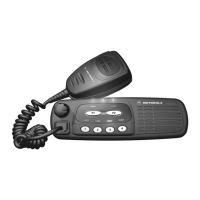VHF (136–174 MHz) 25–45 W Bipolar Frequency Synthesis Section 8: 2-5
6881091C63-F
R3474 and the current sink, to ground. Both diodes are forward biased into conduction. The
transmitter RF from the directional coupler is routed via D3471 to the harmonic filter and antenna
jack. D3472 also conducts, shunting RF power and preventing it from reaching the receiver port
(RXIN). L3472 is selected to appear as a broadband quarter-wave transmission line, making the
short circuit presented by D3472 appear as an open circuit at the junction of D3472 and the receiver
path.
3.7 Harmonic Filter
Components L3491-L3494 and C3490-C3498 form a nine-pole Chebychev low-pass filter to
attenuate harmonic energy of the transmitter. R3490 is used to drain electrostatic charge that might
otherwise build up on the antenna. The harmonic filter also prevents high level RF signals above the
receiver passband from reaching the receiver circuits, improving spurious response rejection.
3.8 Power Control
The transmitter uses the power control IC (PCIC, U3501) to control the power output of the radio. A
portion of the forward and reflected RF power from the transmitter is sampled by the directional
coupler, rectified and summed, to provide a DC voltage to the RFIN port of the PCIC (pin 1) which is
proportional to the sampled RF power.
The ASFIC contains a digital-to-analog converter (DAC) which provides a reference voltage of the
control loop to the PCIC via R3517. The reference voltage level is programmable through the SPI
line of the PCIC. This reference voltage is proportional to the desired power setting of the
transmitter, and is factory programmed at several points across the frequency range of the
transmitter to offset frequency response variations of the transmitter’s power detector circuit.
The PCIC provides a DC output voltage at pin 4 (INT) which is amplified and shifted in DC level by
stages Q3501 and Q3502. The 0 to 4 VDC range at U1503, pin 4 is translated to a 0 to 8.5 VDC
range at the output of Q3501, and applied as VCONT to the power-adjust input pin of the first
transmitter stage U3401. This adjusts the transmitter power output to the intended value. Variations
in forward or reflected transmitter power cause the DC voltage at pin 1 to change, and the PCIC
adjusts the control voltage above or below its nominal value to raise or lower output power.
Capacitors C3502-4, in conjunction with resistors and integrators within the PCIC, control the
transmitter power-rise (key-up) and power-decay (de-key) characteristic to minimize splatter into
adjacent channels.
U3502 is a temperature-sensing device, which monitors the circuit board temperature in the vicinity
of the transmitter driver and final devices, and provides a DC voltage to the PCIC (TEMP, pin 29)
proportional to temperature. If the DC voltage produced exceeds the set threshold in the PCIC, the
transmitter output power is reduced so as to reduce the transmitter temperature.
4.0 VHF (136–174 MHz) 25–45 W Bipolar Frequency Synthesis
The frequency synthesizer subsystem consists of the reference oscillator (Y3261 or Y3262), the
Low Voltage Fractional-N synthesizer (LVFRAC-N, U3201), and the voltage-controlled oscillators
and buffer amplifiers (U3301, Q3301-2 and associated circuits).
4.1 Reference Oscillator
The reference oscillator (Y3262) contains a temperature compensated crystal oscillator with a
frequency of 16.8 MHz. An analog-to-digital (A/D) converter internal to U3201 (LVFRAC-N) and

